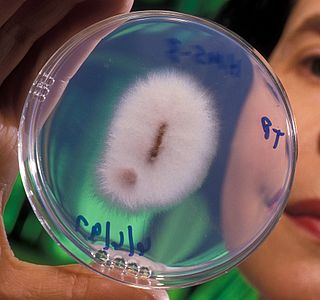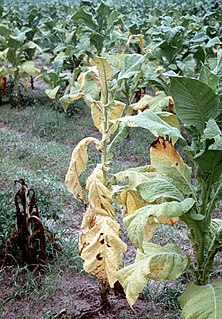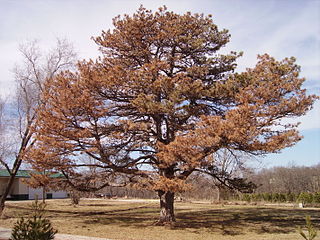
Fusarium oxysporumpronounce (help·info), an ascomycete fungus, comprises all the species, varieties and forms recognized by Wollenweber and Reinking within an infrageneric grouping called section Elegans. It is part of the family Nectriaceae.

Fusarium wilt is a common vascular wilt fungal disease, exhibiting symptoms similar to Verticillium wilt. This disease has been investigated extensively since the early years of this century. The pathogen that causes Fusarium wilt is Fusarium oxysporum. The species is further divided into formae speciales based on host plant.
Panama disease is a plant disease that infects banana plants. It is a wilting disease caused by the fungus Fusarium oxysporum f. sp. cubense (Foc). The pathogen is resistant to fungicides and its control is limited to phytosanitary measures.

Nufar basil is the first variety of sweet basil that is resistant to fusarium wilt. Fusarium wilt is a disease that causes sudden wilting and death in multiple species, including basil. It is caused by the fungus Fusarium oxysporum f. sp. basilicum, which attacks the xylem in the stem, blocking water uptake and leading to a characteristic sudden leaf wilt that does not respond to watering. Nufar basil is resistant to fusarium wilt, remaining asymptomatic even when infected. It was released in 1999 in Israel by the breeders of the Agricultural Research Organization, and commercialized by Genesis Seeds.

Gibberella zeae, also known by the name of its anamorph Fusarium graminearum, is a fungal plant pathogen which causes fusarium head blight, a devastating disease on wheat and barley. The pathogen is responsible for billions of dollars in economic losses worldwide each year. Infection causes shifts in the amino acid composition of wheat, resulting in shriveled kernels and contaminating the remaining grain with mycotoxins, mainly deoxynivalenol, which inhibits protein biosynthesis; and zearalenone, an estrogenic mycotoxin. These toxins cause vomiting, liver damage, and reproductive defects in livestock, and are harmful to humans through contaminated food. Despite great efforts to find resistance genes against F. graminearum, no completely resistant variety is currently available. Research on the biology of F. graminearum is directed towards gaining insight into more details about the infection process and reveal weak spots in the life cycle of this pathogen to develop fungicides that can protect wheat from scab infection.
Ceratocystis paradoxa or Black Rot of Pineapple is a plant pathogen that is a fungus part of the phylum Ascomycota. It is characterized as the teleomorph or sexual reproduction stage of infection. This stage contains ascocarps, or sacs/fruiting bodies, which contain the sexually produced inoculating ascospores. These are the structures which are used primarily to survive long periods of time or overwinter to prepare for the next growing season of its host. Unfortunately, the sexual stage is not often seen in the natural field but instead the anamorph, or asexual stage is more commonly seen. This asexual stage name is Thielaviopsis paradoxa and is the common cause of Black rot or stem-end rot of its hosts.
Fusarium oxysporum f.sp. betae is a destructive fungal plant pathogen. It causes Fusarium yellows or fusarium wilt, characterized by yellowing and dwarfing.

Fusarium oxysporum f.sp. ciceris is a fungal plant pathogen that causes fusarium wilt of chickpea.
Fusarium oxysporum f.sp. radicis-lycopersici is a fungal plant pathogen.
Pyrenochaeta terrestris is a fungal plant pathogen infecting maize, sweet potatoes and strawberries. This plant pathogen causes a disease in onion that is commonly called Pink Root.

Fusarium solani is a species complex of at least 26 closely related filamentous fungi in the division Ascomycota, family Nectriaceae. It is the anamorph of Nectria haematococca. It is a common soil fungus and colonist of plant materials. Fusarium solani is implicated in plant disease as well as human disease notably infection of the cornea of the eye.

Gibberella fujikuroi is a fungal plant pathogen. It causes bakanae disease in rice seedlings.

A wilt disease is any number of diseases that affect the vascular system of plants. Attacks by fungi, bacteria, and nematodes can cause rapid killing of plants, large tree branches or even entire trees. Plants have viruses too.
Black rot, caused by the bacterium Xanthomonas campestris pv. campestris (Xcc), is considered the most important and most destructive disease of crucifers, infecting all cultivated varieties of brassicas worldwide. This disease was first described by botanist and entomologist Harrison Garman in Lexington, Kentucky, US in 1889. Since then, it has been found in nearly every country in which vegetable brassicas are commercially cultivated.

Fusarium oxysporum f. sp. cubensePronunciation (help·info) is a fungal plant pathogen that causes Panama disease of banana, also known as fusarium wilt of banana.

Fusarium circinatum is a fungal plant pathogen that causes the serious disease pitch canker on pine trees and Douglas fir. The most common hosts of the pathogen include slash pine, loblolly pine, Monterey pine, Mexican weeping pine, and Douglas fir. Like other Fusarium species in the phylum Ascomycota, it is the asexual reproductive state of the fungus and has a teleomorph, Gibberella circinata.
The mycorrhizosphere is the region around a mycorrhizal fungus in which nutrients released from the fungus increase the microbial population and its activities. The roots of most terrestrial plants, including most crop plants and almost all woody plants, are colonized by mycorrhiza-forming symbiotic fungi. In this relationship, the plant roots are infected by a fungus, but the rest of the fungal mycelium continues to grow through the soil, digesting and absorbing nutrients and water and sharing these with its plant host. The fungus in turn benefits by receiving photosynthetic sugars from its host. The mycorrhizosphere consists of roots, hyphae of the directly connected mycorrhizal fungi, associated microorganisms, and the soil in their direct influence.
Fusarium dry rot is one of the most common potato diseases. It is caused by fungi in the genus Fusarium. This fungi causes a variety of colored rots in potatoes. This pathogen, while having both a sexual and asexual form, stays in an asexual cycle due to the way it spreads. Preferring warmer climates, it is not uncommon to find this pathogen in the northern United States where it has been reported to affect yield as much as 60%.
Black point is often considered a fungal disease that affects wheat, barley and rye. It is thought to be caused by various species of Alternaria, Fusarium, and Helminthosporium, and possibly other fungal genera. The fungus forms after the seeds have set but while they are still green and it is potentiated by high humidity. Infected areas are brown to black in color, and as the disease spreads the kernels may become shriveled. Occasionally the infected areas have a reddish tinge.

Koa wilt is a relatively new disease to Hawaii, discovered in 1980. Koa wilt is caused by a forma specialis of the fungus Fusarium oxysporum, which is now abundant in Hawaiian soils and infects the native Acacia koa tree, a once-dominant species in the canopy of Hawaiian forests. Fusarium oxysporum f.sp. koae is believed to have been brought into Hawaii on an ornamental acacia plant. Fusarium fungi clog the tree xylem, causing significant wilt and mortality among these beautiful and iconic Hawaiian trees.








